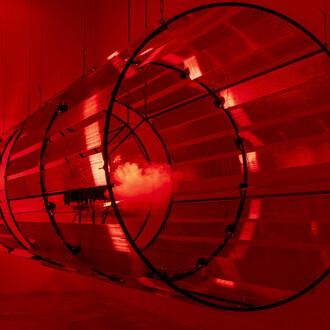In ancient Andean traditions, the human being is living earth: I am a body, I am earth. In the exhibition space, the earth expresses itself; it is the center and the mirror of what we are.
(Delcy Morelos)
Delcy Morelos (Tierralta, Colombia, 1967) explores into universal mythological worldviews, particularly pre-Columbian ones, to emphasize the interdependence among humans, animals, plants, and spirits, all born from the same seed, that of the Pachamama of Inca cultures, the Bachué of the Chibchas from her homeland, the "Mother Earth", a term adopted by the United Nations to refer to our planet (2009). To do so, she employs mediums ranging from large-format watercolors to extensive earth installations that transform the spaces they inhabit.
Morelos studied at the School of Fine Arts in Cartagena and began her career as a painter working on traditional surfaces, with a preference for reds —"I felt that red was not just a color; I perceived it as a substance emanating from my fingers".—but since she started working with earth, her exploration of color has taken her in different directions: "Earth can be of many colors: blue, gray-green, light brown, dark brown, yellow, ochre, orange, black, or red. [...] In my early earth works, the soil is red. What makes the soil red is the large amount of iron it contains, the same element that makes the blood flowing through our veins red. There is a deep relationship between us, humans, and the earth, and we have lost that awareness."
Thus, from the perspective of a nature that is sacred, mythical, and simultaneously a living being with which we are intimately connected, Morelos proposes respecting the spirit of all elements of nature and caring for the balance of ecosystems. Earth, sand, albero are the materials Morelos uses to design, through geometric minimalism, enveloping, immersive, and multisensory forms in the shape of caves, mastabas, ziggurats, pyramids, or thresholds, where the viewer is sensually surrounded by the fertility of the earth and its generative power, and can come to a broader understanding of reality, including spiritual, energetic, and cosmic dimensions beyond the visible. Through the use of organic materials, she explores concepts related to fertility, creativity, and transformation as catalysts for societal change.
Profundis is a journey towards reconnecting with historical memory through aroma, with earth as an ancestral element, where species and plants like tobacco, corn, tomato, or potato, introduced to Europe from the Americas, return, invading the exhibition space of the Monumental Zone of the Cartuja monastery with their perfumes and textures.
















